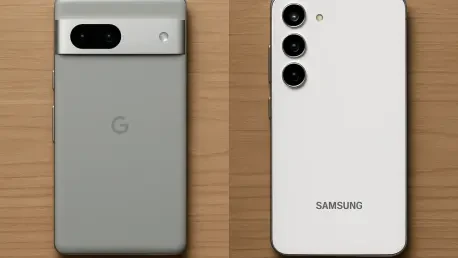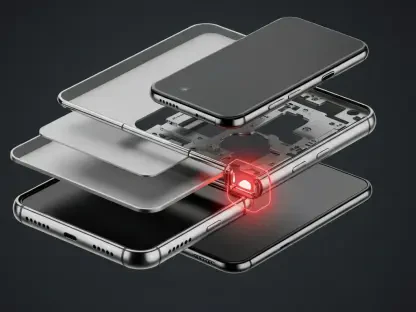In an era where smartphones define personal and professional connectivity, the battle for supremacy between flagship devices captivates tech enthusiasts globally, with over a billion units shipped annually shaping consumer trends. The Google Pixel 10 series, encompassing the Pixel 10, Pixel 10 Pro, and Pixel 10 Pro XL, stands as a pinnacle of innovation from Google, promising cutting-edge features and seamless integration. Similarly, the Samsung Galaxy S25 series, including the S25, S25 Ultra, and S25 Edge, reinforces Samsung’s legacy of blending style with performance, catering to a vast audience seeking premium experiences.
These flagship lineups are not just gadgets but symbols of technological progress, pushing boundaries in hardware capabilities, design aesthetics, and user-centric functionalities. Their rivalry fuels advancements that redefine what smartphones can achieve, from photography to processing power, influencing market dynamics significantly. Both series target diverse consumer segments, with Google emphasizing AI-driven enhancements and Samsung focusing on versatile hardware, setting the stage for an in-depth exploration of their strengths and differences.
This comparison delves into critical aspects such as performance, camera systems, battery efficiency, and design philosophies to provide clarity on how these devices align with varying user needs. By examining their specifications and anticipated real-world impacts, a clearer picture emerges of their standing in a highly competitive landscape. The analysis aims to guide potential buyers through the nuances of each offering, highlighting what sets them apart in today’s tech ecosystem.
Head-to-Head Feature Comparison
Performance and Chipset Technology
At the heart of the Pixel 10 series lies the TSMC-made Tensor G5 chipset, a significant shift in manufacturing that promises enhanced efficiency and power for tasks ranging from gaming to productivity. This chipset is engineered to optimize AI functionalities, potentially offering smoother multitasking and faster app launches across all models. While exact benchmark results are pending, early indications suggest a focus on balancing performance with energy conservation, which could redefine user expectations.
In contrast, the Galaxy S25 series is powered by the Snapdragon 8 Elite chipset, known for its raw speed and robust handling of intensive applications, especially in the S25 Ultra variant. Samsung’s choice reflects a commitment to delivering top-tier processing capabilities, likely excelling in scenarios requiring high graphical output or complex computations. The difference in chipset architecture between the two brands hints at varied approaches to performance, with Samsung possibly taking the lead in sheer speed.
The impact of these technological choices on everyday use remains a key point of interest, as efficiency in power management could tilt the scales for users prioritizing longevity over peak performance. Until hands-on testing provides concrete data, speculation centers on how Tensor G5’s AI optimizations might stack up against Snapdragon’s brute force. This aspect underscores a broader narrative of innovation tailored to distinct user priorities in the flagship arena.
Camera Systems and Imaging Capabilities
Turning to photography, the Pixel 10 introduces a groundbreaking 10.5MP 5x telephoto lens in its base model, a first for non-Pro Pixels, while the Pro and Pro XL models elevate this with a 48MP 5x telephoto for superior zoom clarity. Google’s emphasis on computational photography, paired with larger sensors in Pro variants, suggests an edge in capturing detailed, vibrant images under diverse lighting conditions. Although final image quality assessments await real-world testing, the specs indicate a strong push toward professional-grade results.
The Galaxy S25, on the other hand, equips its base model with a 10MP 3x telephoto lens, while the S25 Ultra boasts premium imaging hardware designed to rival top-tier competitors. Samsung’s focus appears to be on refining ultra-wide shots and overall sensor performance, though it may lag behind Pixel’s telephoto advancements in zoom capabilities. The disparity in lens specifications points to different focal points, with Samsung possibly prioritizing versatility over specialized zoom features.
Evaluating both, the potential for Pixel’s camera system to excel in zoomed-in photography contrasts with Samsung’s broader imaging consistency, creating a nuanced choice for photography enthusiasts. Without hands-on comparisons, the discussion leans on promised features, such as Google’s AI enhancements versus Samsung’s hardware-driven approach. This segment of the comparison highlights how each brand caters to unique visual storytelling needs, awaiting further validation through user feedback.
Battery Life and Charging Innovations
Battery endurance is a critical factor, with the Pixel 10 series nearing a 5,000mAh capacity across its models, and the Pro XL pushing to 5,200mAh alongside 45W wired and 25W Qi2 wireless charging. This robust capacity suggests prolonged usage without frequent recharges, a boon for power users engaging in media consumption or heavy multitasking. The inclusion of magnetic Qi2 charging further enhances convenience, offering seamless integration with compatible accessories.
Comparatively, the Galaxy S25 base model features a 4,000mAh battery, while the S25 Ultra steps up to compete more closely with Pixel’s offerings, though exact figures remain under scrutiny. Charging speeds are competitive, yet the absence of magnetic Qi2 technology in Samsung’s lineup could limit flexibility for users invested in wireless ecosystems. This gap in innovation might affect practicality for those seeking modern charging solutions without additional adapters.
The trade-offs are evident: Pixel’s superior battery size and charging versatility cater to users needing reliability on the go, whereas Samsung’s approach may appeal to those satisfied with standard capacities and traditional charging methods. The real-world implications of these differences, such as hours of screen time or charging frequency, will ultimately shape user satisfaction. For now, Pixel appears to hold an advantage in addressing endurance concerns prevalent among smartphone users.
Design, Build, and Ecosystem Considerations
Design philosophies reveal distinct priorities, with the Pixel 10 series emphasizing durability, as seen in the Pixel 10 Pro Fold’s IP68 rating for dust and water resistance, ensuring robustness against environmental challenges. The overall aesthetic leans toward a premium, sturdy build, appealing to users who value longevity and resilience in their devices. However, the bulkier design of certain models, like the Pro Fold at 258g, might deter those seeking sleeker profiles.
Samsung counters with a focus on lightweight construction, exemplified by the S25 Edge weighing just 163g despite a large 6.7-inch display, prioritizing portability without sacrificing screen real estate. This approach targets consumers who prefer devices that feel less cumbersome during daily use, though it sometimes comes at the cost of smaller battery capacities. The balance between weight and functionality remains a defining factor in Samsung’s design narrative, contrasting with Google’s rugged focus.
Ecosystem integration further differentiates the two, as Google pairs the Pixel 10 series with accessories like the Pixel Watch 4, featuring Satellite SOS for emergency connectivity, and Pixel Buds 2a for immersive audio, albeit with shipping delays until October. Samsung’s Galaxy Watch8 offers perks like a bundled SmartTag for tracking, alongside the Buds3 series, enhancing user connectivity within its ecosystem. Pricing strategies also play a role, with Google’s pre-order incentives, such as Amazon gift cards, providing added value compared to Samsung’s recurring battery limitations, shaping consumer perceptions of overall worth.
Final Verdict: Which Flagship Suits Your Needs?
Reflecting on the comparison, the Pixel 10 series stands out for its impressive battery capacities and innovative camera features, particularly the telephoto advancements across models, catering to users who prioritize endurance and photography excellence. Conversely, the Galaxy S25 series impresses with its lightweight designs and potent Snapdragon 8 Elite chipset, appealing to those who value portability and raw performance in their daily interactions with technology.
For those who place battery life and cutting-edge imaging at the forefront, the Pixel 10 emerges as a compelling choice, especially with added conveniences like Qi2 charging enhancing usability. On the other hand, the Galaxy S25 suits individuals drawn to sleek builds and powerful processing, particularly in scenarios demanding high-speed operations or a less bulky device, despite some compromises in battery size.
Looking ahead, potential buyers are encouraged to monitor upcoming hands-on reviews and test these devices in real-world settings to confirm which aligns best with their unique lifestyles. Considering personal priorities—whether it’s capturing stunning visuals or enjoying a featherlight feel—remains crucial in navigating this flagship duel. As the tech landscape continues to evolve, staying informed about software updates and accessory compatibility will further refine the decision-making process for these remarkable smartphones.









